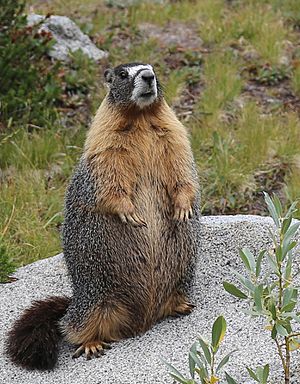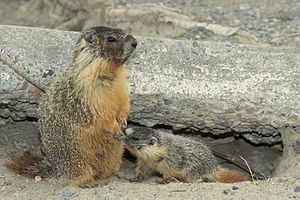Yellow-bellied marmot facts for kids
Quick facts for kids Yellow-bellied marmot |
|
|---|---|
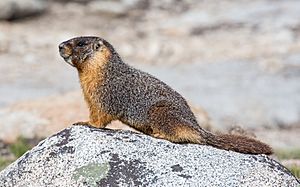 |
|
| Yellow-bellied marmot in Tuolumne Meadows, Yosemite National Park | |
| Conservation status | |
| Scientific classification | |
| Genus: |
Marmota
|
| Species: |
flaviventris
|
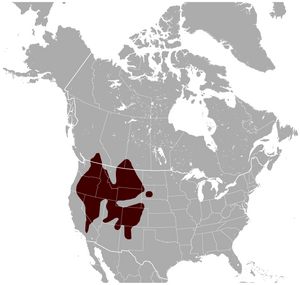 |
|
| Yellow-bellied Marmot range | |
The yellow-bellied marmot (Marmota flaviventris) is a large, furry ground squirrel. It is also known as the rock chuck. This animal is one of 14 types of marmots. It lives in the mountains of southwestern Canada and the western United States. You can find them in places like the Rocky Mountains and the Sierra Nevada. They usually live high up, above 6,500 feet (about 1,980 meters).
Yellow-bellied marmots have brown fur, a dark bushy tail, and a yellow chest. They also have a white patch between their eyes. These marmots can weigh up to 5 kilograms (about 11 pounds). They live in burrows in groups called colonies. A colony can have up to 20 marmots with one main male. They are active during the day and eat plants, insects, and bird eggs. They hibernate for about eight months, from September through the winter.
Contents
What Does a Yellow-Bellied Marmot Look Like?
Adult yellow-bellied marmots usually weigh from 1.6 to 5.2 kilograms (3.5 to 11.5 pounds). Males are typically heavier than females. Their weight changes a lot during the year. They are lightest in early spring and heaviest in early autumn. Adult males usually weigh between 3 and 5 kilograms (6.6 to 11 pounds). Adult females weigh between 1.6 and 4 kilograms (3.5 to 8.8 pounds).
These marmots are about 47 to 68 centimeters (18.5 to 26.8 inches) long. Their short tails are 13 to 21 centimeters (5.1 to 8.3 inches) long. The tail has buffy, reddish, and black hairs. Their back feet are 7 to 9 centimeters (2.8 to 3.5 inches) long.
They have a broad, flat skull and a dark head. Their nose is dark with a white furry patch. Their fur has long, coarse outer hairs and woolly, shorter underfurs. The brown coat has a white patch of fur on the snout. Their scientific and common names come from the bright yellow fur on their belly, neck, and throat. Their ears are small and round, about 1.8 to 2.2 centimeters (0.7 to 0.9 inches) long. Their back is reddish-brown with black and light-grey tan patches. Their feet are yellowish to dark brown. In autumn, they gain extra fat to get ready for hibernation.
Where Do Yellow-Bellied Marmots Live?
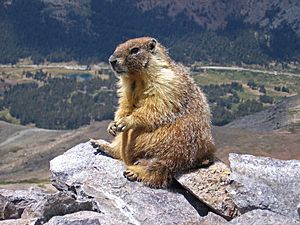
The yellow-bellied marmot lives in southwestern Canada and the western United States. This includes the Rocky Mountains and the Sierra Nevada. Northwards, they live in southern British Columbia. Eastwards, they are found in the mountain and basin areas of Wyoming, eastern Montana, Colorado, and southern Alberta. Southwards, their range reaches northern New Mexico.
They live in steppes, meadows, rocky fields, and other open areas. Sometimes they live near deciduous or coniferous forests. You can find them from as low as 5,400 feet (1,646 meters) to over 14,000 feet (4,267 meters) high.
Marmots are found in valleys, meadows, and foothills. They like open areas without much plants. Their territory is about 6 acres (2.4 hectares) around several burrows. They dig these burrows during the summer. They often dig burrows under rocks. This makes them harder for predators to see. Predators include foxes, dogs, coyotes, wolves, and eagles. When a marmot sees a predator, it whistles to warn others. Then, it usually hides in a nearby rock pile until the danger is gone.
Marmot Life and Habits
Behavior and Reproduction

Marmots start having babies when they are about two years old. They can live up to 15 years. They live in colonies of about 10 to 20 marmots. Each male marmot digs a burrow soon after waking from hibernation. Then, it looks for females to mate with. By summer, a male might have up to four female mates.
Females usually have 3 to 5 babies (pups) in each litter. Only about half of these pups survive to be yearlings (one-year-olds). Male marmots often mate with two or three females at the same time. Female offspring tend to stay near their home area. Male offspring usually leave when they are yearlings. They will then defend one or more females.
Yellow-bellied marmots spend about 80% of their lives in their burrows. About 60% of that time is spent hibernating. They also spend the middle of the day and night in a burrow. These burrows are usually built on a slope, like a hill or cliff. Hibernating burrows can be 5 to 7 meters (16 to 23 feet) deep. However, burrows for daily use are usually only about 1 meter (3.3 feet) deep. Their hibernation time changes depending on how high up they live. But it is usually from September to May. Sometimes, they climb trees, but they mostly stay on the ground.
What Do Marmots Eat?
Yellow-bellied marmots are active during the day. They are less active at night. They are omnivores, meaning they eat both plants and animals. But they mostly eat a wide variety of plants. They are generalist herbivores. They mainly feed on grass, grains, leaves, flowers, legumes, bird eggs, and insects. Sometimes, they also eat fruits and the bark of fruit trees.
Marmots are known to avoid plants that have harmful chemicals. For example, they eat the flowers of lupinus, larkspur, and columbine. But they avoid the shoots of these plants because they contain toxic compounds. Their food choices depend on how much fat and protein the plants have. Plants like cinquefoil, cow-parsnip, and dandelion leaves are good sources. In late summer, grasses, forbs (non-woody plants), and seeds make up most of their diet. They also like to eat alfalfa and clover. They drink less water because their plant diet gives them most of the water they need.
Marmot Status and Conservation
Since 1996, the yellow-bellied marmot has been listed as a least concern species. This means it is not in danger of disappearing. The IUCN Red List of Endangered Species keeps track of this. There are no big threats to this species. It is also protected in several areas where it lives. So, there is not much worry about needing special conservation efforts for them right now.
See also
 In Spanish: Marmota de vientre amarillo para niños
In Spanish: Marmota de vientre amarillo para niños



